
MarkLLM
MarkLLM: An Open-Source Toolkit for LLM Watermarking.(EMNLP 2024 Demo)
Stars: 326
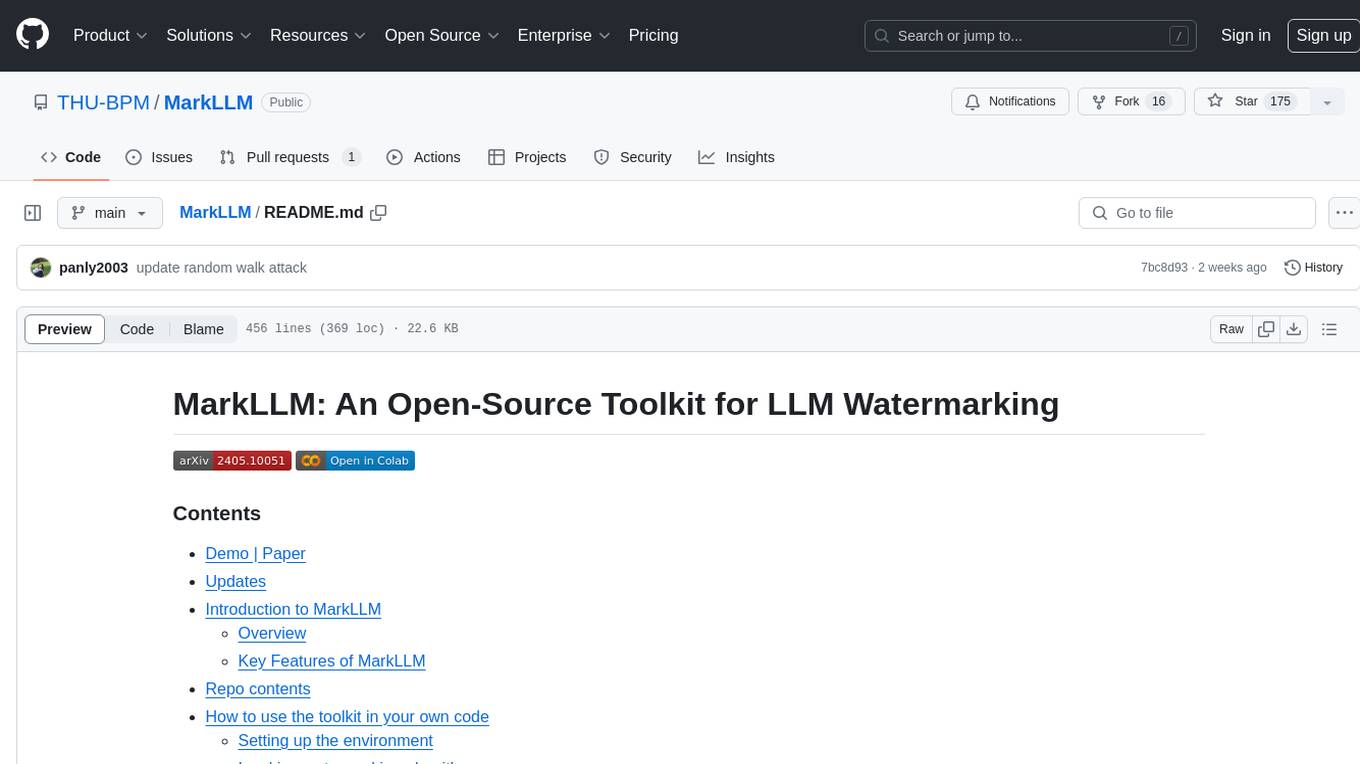
MarkLLM is an open-source toolkit designed for watermarking technologies within large language models (LLMs). It simplifies access, understanding, and assessment of watermarking technologies, supporting various algorithms, visualization tools, and evaluation modules. The toolkit aids researchers and the community in ensuring the authenticity and origin of machine-generated text.
README:
🎉 We welcome PRs! If you have implemented a LLM watermarking algorithm or are interested in contributing one, we'd love to include it in MarkLLM. Join our community and help make text watermarking more accessible to everyone!


- MarkLLM: An Open-Source Toolkit for LLM Watermarking
- Google Colab: We utilize Google Colab as our platform to fully publicly demonstrate the capabilities of MarkLLM through a Jupyter Notebook.
- Video Introduction: We provide a video introduction of our system on YouTube to faciliate easy understanding.
- Website Demo: We have also developed a website to facilitate interaction. Due to resource limitations, we cannot offer live access to everyone. Instead, we provide a demonstration video.
- Paper:''MarkLLM: An Open-source toolkit for LLM Watermarking'' by Leyi Pan, Aiwei Liu*, Zhiwei He, Zitian Gao, Xuandong Zhao, Yijian Lu, Binglin Zhou, Shuliang Liu, Xuming Hu, Lijie Wen, Irwin King, Philip S. Yu
- 🎉 (2025.01.08) Add AutoConfiguration for watermarking methods.
- 🎉 (2024.12.21) Provide example code for integrating VLLM with MarkLLM in
MarkvLLM_demo.py. Thanks to @zhangjf-nlp for his PR! - 🎉 (2024.11.21) Support distortionary version of SynthID-Text method (Nature).
- 🎉 (2024.11.03) Add SynthID-Text method (Nature) and support detection methods including mean, weighted mean, and bayesian.
- 🎉 (2024.11.01) Add TS-Watermark method (ICML 2024). Thanks to Kyle Zheng and Minjia Huo for their PR!
- 🎉 (2024.10.07) Provide an alternative, equivalent implementation of the EXP watermarking algorithm (EXPGumbel) utilizing Gumbel noise. With this implementation, users should be able to modify the watermark strength by adjusting the sampling temperature in the configuration file.
- 🎉 (2024.10.07) Add Unbiased watermarking method.
- 🎉 (2024.10.06) We are excited to announce that our paper "MarkLLM: An Open-Source Toolkit for LLM Watermarking" has been accepted by EMNLP 2024 Demo!
- 🎉 (2024.08.08) Add DiPmark watermarking method. Thanks to Sheng Guan for his PR!
- 🎉 (2024.08.01) Released as a python package! Try
pip install markllm. We provide a user example at the end of this file. - 🎉 (2024.07.13) Add ITSEdit watermarking method. Thanks to Yiming Liu for his PR!
- 🎉 (2024.07.09) Add more hashing schemes for KGW (skip, min, additive, selfhash). Thanks to Yichen Di for his PR!
- 🎉 (2024.07.08) Add top-k filter for watermarking methods in Christ family. Thanks to Kai Shi for his PR!
- 🎉 (2024.07.03) Updated Back-Translation Attack. Thanks to Zihan Tang for his PR!
- 🎉 (2024.06.19) Updated Random Walk Attack from the impossibility results of strong watermarking paper at ICML, 2024. (Blog). Thanks to Hanlin Zhang for his PR!
- 🎉 (2024.05.23) We're thrilled to announce the release of our website demo!
MarkLLM is an open-source toolkit developed to facilitate the research and application of watermarking technologies within large language models (LLMs). As the use of large language models (LLMs) expands, ensuring the authenticity and origin of machine-generated text becomes critical. MarkLLM simplifies the access, understanding, and assessment of watermarking technologies, making it accessible to both researchers and the broader community.
-
Implementation Framework: MarkLLM provides a unified and extensible platform for the implementation of various LLM watermarking algorithms. It currently supports nine specific algorithms from two prominent families, facilitating the integration and expansion of watermarking techniques.
Framework Design:
Currently Supported Algorithms:
-
Visualization Solutions: The toolkit includes custom visualization tools that enable clear and insightful views into how different watermarking algorithms operate under various scenarios. These visualizations help demystify the algorithms' mechanisms, making them more understandable for users.

-
Evaluation Module: With 12 evaluation tools that cover detectability, robustness, and impact on text quality, MarkLLM stands out in its comprehensive approach to assessing watermarking technologies. It also features customizable automated evaluation pipelines that cater to diverse needs and scenarios, enhancing the toolkit's practical utility.
Tools:
- Success Rate Calculator of Watermark Detection: FundamentalSuccessRateCalculator, DynamicThresholdSuccessRateCalculator
- Text Editor: WordDeletion, SynonymSubstitution, ContextAwareSynonymSubstitution, GPTParaphraser, DipperParaphraser, RandomWalkAttack
- Text Quality Analyzer: PPLCalculator, LogDiversityAnalyzer, BLEUCalculator, PassOrNotJudger, GPTDiscriminator
Pipelines:
- Watermark Detection Pipeline: WatermarkedTextDetectionPipeline, UnwatermarkedTextDetectionPipeline
- Text Quality Pipeline: DirectTextQualityAnalysisPipeline, ReferencedTextQualityAnalysisPipeline, ExternalDiscriminatorTextQualityAnalysisPipeline
Below is the directory structure of the MarkLLM project, which encapsulates its three core functionalities within the watermark/, visualize/, and evaluation/ directories. To facilitate user understanding and demonstrate the toolkit's ease of use, we provide a variety of test cases. The test code can be found in the test/ directory.
MarkLLM/
├── config/ # Configuration files for various watermark algorithms
│ ├── EWD.json
│ ├── EXPEdit.json
│ ├── EXP.json
│ ├── KGW.json
│ ├── ITSEdit.json
│ ├── SIR.json
│ ├── SWEET.json
│ ├── Unigram.json
│ ├── UPV.json
│ └── XSIR.json
├── dataset/ # Datasets used in the project
│ ├── c4/
│ ├── human_eval/
│ └── wmt16_de_en/
├── evaluation/ # Evaluation module of MarkLLM, including tools and pipelines
│ ├── dataset.py # Script for handling dataset operations within evaluations
│ ├── examples/ # Scripts for automated evaluations using pipelines
│ │ ├── assess_detectability.py
│ │ ├── assess_quality.py
│ │ └── assess_robustness.py
│ ├── pipelines/ # Pipelines for structured evaluation processes
│ │ ├── detection.py
│ │ └── quality_analysis.py
│ └── tools/ # Evaluation tools
│ ├── oracle.py
│ ├── success_rate_calculator.py
├── text_editor.py
│ └── text_quality_analyzer.py
├── exceptions/ # Custom exception definitions for error handling
│ └── exceptions.py
├── font/ # Fonts needed for visualization purposes
├── MarkLLM_demo.ipynb # Jupyter Notebook
├── test/ # Test cases and examples for user testing
│ ├── test_method.py
│ ├── test_pipeline.py
│ └── test_visualize.py
├── utils/ # Helper classes and functions supporting various operations
│ ├── openai_utils.py
│ ├── transformers_config.py
│ └── utils.py
├── visualize/ # Visualization Solutions module of MarkLLM
│ ├── color_scheme.py
│ ├── data_for_visualization.py
│ ├── font_settings.py
│ ├── legend_settings.py
│ ├── page_layout_settings.py
│ └── visualizer.py
├── watermark/ # Implementation framework for watermark algorithms
│ ├── auto_watermark.py # AutoWatermark class
│ ├── base.py # Base classes and functions for watermarking
│ ├── ewd/
│ ├── exp/
│ ├── exp_edit/
│ ├── kgw/
│ ├── its_edit/
│ ├── sir/
│ ├── sweet/
│ ├── unigram/
│ ├── upv/
│ └── xsir/
├── README.md # Main project documentation
└── requirements.txt # Dependencies required for the project
- python 3.9
- pytorch
- pip install -r requirements.txt
Tips: If you wish to utilize the EXPEdit or ITSEdit algorithm, you will need to import for .pyx file, take EXPEdit as an example:
- run
python watermark/exp_edit/cython_files/setup.py build_ext --inplace - move the generated
.sofile intowatermark/exp_edit/cython_files/
import torch
from watermark.auto_watermark import AutoWatermark
from utils.transformers_config import TransformersConfig
from transformers import AutoModelForCausalLM, AutoTokenizer
# Device
device = "cuda" if torch.cuda.is_available() else "cpu"
# Transformers config
transformers_config = TransformersConfig(model=AutoModelForCausalLM.from_pretrained('facebook/opt-1.3b').to(device),
tokenizer=AutoTokenizer.from_pretrained('facebook/opt-1.3b'),
vocab_size=50272,
device=device,
max_new_tokens=200,
min_length=230,
do_sample=True,
no_repeat_ngram_size=4)
# Load watermark algorithm
myWatermark = AutoWatermark.load('KGW',
algorithm_config='config/KGW.json',
transformers_config=transformers_config)
# Prompt
prompt = 'Good Morning.'
# Generate and detect
watermarked_text = myWatermark.generate_watermarked_text(prompt)
detect_result = myWatermark.detect_watermark(watermarked_text)
unwatermarked_text = myWatermark.generate_unwatermarked_text(prompt)
detect_result = myWatermark.detect_watermark(unwatermarked_text)Assuming you already have a pair of watermarked_text and unwatermarked_text, and you wish to visualize the differences and specifically highlight the watermark within the watermarked text using a watermarking algorithm, you can utilize the visualization tools available in the visualize/ directory.
KGW Family
import torch
from visualize.font_settings import FontSettings
from watermark.auto_watermark import AutoWatermark
from utils.transformers_config import TransformersConfig
from transformers import AutoModelForCausalLM, AutoTokenizer
from visualize.visualizer import DiscreteVisualizer
from visualize.legend_settings import DiscreteLegendSettings
from visualize.page_layout_settings import PageLayoutSettings
from visualize.color_scheme import ColorSchemeForDiscreteVisualization
# Load watermark algorithm
device = "cuda" if torch.cuda.is_available() else "cpu"
transformers_config = TransformersConfig(
model=AutoModelForCausalLM.from_pretrained('facebook/opt-1.3b').to(device),
tokenizer=AutoTokenizer.from_pretrained('facebook/opt-1.3b'),
vocab_size=50272,
device=device,
max_new_tokens=200,
min_length=230,
do_sample=True,
no_repeat_ngram_size=4)
myWatermark = AutoWatermark.load('KGW',
algorithm_config='config/KGW.json',
transformers_config=transformers_config)
# Get data for visualization
watermarked_data = myWatermark.get_data_for_visualization(watermarked_text)
unwatermarked_data = myWatermark.get_data_for_visualization(unwatermarked_text)
# Init visualizer
visualizer = DiscreteVisualizer(color_scheme=ColorSchemeForDiscreteVisualization(),
font_settings=FontSettings(),
page_layout_settings=PageLayoutSettings(),
legend_settings=DiscreteLegendSettings())
# Visualize
watermarked_img = visualizer.visualize(data=watermarked_data,
show_text=True,
visualize_weight=True,
display_legend=True)
unwatermarked_img = visualizer.visualize(data=unwatermarked_data,
show_text=True,
visualize_weight=True,
display_legend=True)
# Save
watermarked_img.save("KGW_watermarked.png")
unwatermarked_img.save("KGW_unwatermarked.png")Christ Family
import torch
from visualize.font_settings import FontSettings
from watermark.auto_watermark import AutoWatermark
from utils.transformers_config import TransformersConfig
from transformers import AutoModelForCausalLM, AutoTokenizer
from visualize.visualizer import ContinuousVisualizer
from visualize.legend_settings import ContinuousLegendSettings
from visualize.page_layout_settings import PageLayoutSettings
from visualize.color_scheme import ColorSchemeForContinuousVisualization
# Load watermark algorithm
device = "cuda" if torch.cuda.is_available() else "cpu"
transformers_config = TransformersConfig(
model=AutoModelForCausalLM.from_pretrained('facebook/opt-1.3b').to(device),
tokenizer=AutoTokenizer.from_pretrained('facebook/opt-1.3b'),
vocab_size=50272,
device=device,
max_new_tokens=200,
min_length=230,
do_sample=True,
no_repeat_ngram_size=4)
myWatermark = AutoWatermark.load('EXP',
algorithm_config='config/EXP.json',
transformers_config=transformers_config)
# Get data for visualization
watermarked_data = myWatermark.get_data_for_visualization(watermarked_text)
unwatermarked_data = myWatermark.get_data_for_visualization(unwatermarked_text)
# Init visualizer
visualizer = ContinuousVisualizer(color_scheme=ColorSchemeForContinuousVisualization(),
font_settings=FontSettings(),
page_layout_settings=PageLayoutSettings(),
legend_settings=ContinuousLegendSettings())
# Visualize
watermarked_img = visualizer.visualize(data=watermarked_data,
show_text=True,
visualize_weight=True,
display_legend=True)
unwatermarked_img = visualizer.visualize(data=unwatermarked_data,
show_text=True,
visualize_weight=True,
display_legend=True)
# Save
watermarked_img.save("EXP_watermarked.png")
unwatermarked_img.save("EXP_unwatermarked.png")For more examples on how to use the visualization tools, please refer to the test/test_visualize.py script in the project directory.
Using Watermark Detection Pipelines
import torch
from evaluation.dataset import C4Dataset
from watermark.auto_watermark import AutoWatermark
from utils.transformers_config import TransformersConfig
from transformers import AutoModelForCausalLM, AutoTokenizer
from evaluation.tools.text_editor import TruncatePromptTextEditor, WordDeletion
from evaluation.tools.success_rate_calculator import DynamicThresholdSuccessRateCalculator
from evaluation.pipelines.detection import WatermarkedTextDetectionPipeline, UnWatermarkedTextDetectionPipeline, DetectionPipelineReturnType
# Load dataset
my_dataset = C4Dataset('dataset/c4/processed_c4.json')
# Device
device = 'cuda' if torch.cuda.is_available() else 'cpu'
# Transformers config
transformers_config = TransformersConfig(
model=AutoModelForCausalLM.from_pretrained('facebook/opt-1.3b').to(device),
tokenizer=AutoTokenizer.from_pretrained('facebook/opt-1.3b'),
vocab_size=50272,
device=device,
max_new_tokens=200,
do_sample=True,
min_length=230,
no_repeat_ngram_size=4)
# Load watermark algorithm
my_watermark = AutoWatermark.load('KGW',
algorithm_config='config/KGW.json',
transformers_config=transformers_config)
# Init pipelines
pipeline1 = WatermarkedTextDetectionPipeline(
dataset=my_dataset,
text_editor_list=[TruncatePromptTextEditor(), WordDeletion(ratio=0.3)],
show_progress=True,
return_type=DetectionPipelineReturnType.SCORES)
pipeline2 = UnWatermarkedTextDetectionPipeline(dataset=my_dataset,
text_editor_list=[],
show_progress=True,
return_type=DetectionPipelineReturnType.SCORES)
# Evaluate
calculator = DynamicThresholdSuccessRateCalculator(labels=['TPR', 'F1'], rule='best')
print(calculator.calculate(pipeline1.evaluate(my_watermark), pipeline2.evaluate(my_watermark)))Using Text Quality Analysis Pipeline
import torch
from evaluation.dataset import C4Dataset
from watermark.auto_watermark import AutoWatermark
from utils.transformers_config import TransformersConfig
from transformers import AutoModelForCausalLM, AutoTokenizer
from evaluation.tools.text_editor import TruncatePromptTextEditor
from evaluation.tools.text_quality_analyzer import PPLCalculator
from evaluation.pipelines.quality_analysis import DirectTextQualityAnalysisPipeline, QualityPipelineReturnType
# Load dataset
my_dataset = C4Dataset('dataset/c4/processed_c4.json')
# Device
device = 'cuda' if torch.cuda.is_available() else 'cpu'
# Transformer config
transformers_config = TransformersConfig(
model=AutoModelForCausalLM.from_pretrained('facebook/opt-1.3b').to(device), tokenizer=AutoTokenizer.from_pretrained('facebook/opt-1.3b'),
vocab_size=50272,
device=device,
max_new_tokens=200,
min_length=230,
do_sample=True,
no_repeat_ngram_size=4)
# Load watermark algorithm
my_watermark = AutoWatermark.load('KGW',
algorithm_config='config/KGW.json',
transformers_config=transformers_config)
# Init pipeline
quality_pipeline = DirectTextQualityAnalysisPipeline(
dataset=my_dataset,
watermarked_text_editor_list=[TruncatePromptTextEditor()],
unwatermarked_text_editor_list=[],
analyzer=PPLCalculator(
model=AutoModelForCausalLM.from_pretrained('..model/llama-7b/', device_map='auto'), tokenizer=LlamaTokenizer.from_pretrained('..model/llama-7b/'),
device=device),
unwatermarked_text_source='natural',
show_progress=True,
return_type=QualityPipelineReturnType.MEAN_SCORES)
# Evaluate
print(quality_pipeline.evaluate(my_watermark))For more examples on how to use the pipelines, please refer to the test/test_pipeline.py script in the project directory.
Leveraging example scripts for evaluation
In the evaluation/examples/ directory of our repository, you will find a collection of Python scripts specifically designed for systematic and automated evaluation of various algorithms. By using these examples, you can quickly and effectively gauge the d etectability, robustness and impact on text quality of each algorithm implemented within our toolkit.
Note: To execute the scripts in evaluation/examples/, first run the following command to set the environment variables.
export PYTHONPATH="path_to_the_MarkLLM_project:$PYTHONPATH"Additional user examples are available in test/. To execute the scripts contained within, first run the following command to set the environment variables.
export PYTHONPATH="path_to_the_MarkLLM_project:$PYTHONPATH"In addition to the Colab Jupyter notebook we provide (some models cannot be downloaded due to storage limits), you can also easily deploy using MarkLLM_demo.ipynb on your local machine.
A user example:
import torch, random
import numpy as np
from markllm.watermark.auto_watermark import AutoWatermark
from markllm.utils.transformers_config import TransformersConfig
from transformers import AutoModelForCausalLM, AutoTokenizer
# Setting random seed for reproducibility
seed = 30
torch.manual_seed(seed)
if torch.cuda.is_available():
torch.cuda.manual_seed_all(seed)
np.random.seed(seed)
random.seed(seed)
# Device
device = "cuda" if torch.cuda.is_available() else "cpu"
# Transformers config
model_name = 'facebook/opt-1.3b'
transformers_config = TransformersConfig(
model=AutoModelForCausalLM.from_pretrained(model_name).to(device),
tokenizer=AutoTokenizer.from_pretrained(model_name),
vocab_size=50272,
device=device,
max_new_tokens=200,
min_length=230,
do_sample=True,
no_repeat_ngram_size=4
)
# Load watermark algorithm
myWatermark = AutoWatermark.load('KGW', transformers_config=transformers_config)
# Prompt and generation
prompt = 'Good Morning.'
watermarked_text = myWatermark.generate_watermarked_text(prompt)
# How would I get started with Python...
unwatermarked_text = myWatermark.generate_unwatermarked_text(prompt)
# I am happy that you are back with ...
# Detection
detect_result_watermarked = myWatermark.detect_watermark(watermarked_text)
# {'is_watermarked': True, 'score': 9.287487590439852}
detect_result_unwatermarked = myWatermark.detect_watermark(unwatermarked_text)
# {'is_watermarked': False, 'score': -0.8443170536763502}If you are interested in text watermarking for large language models, please read our survey: [2312.07913] A Survey of Text Watermarking in the Era of Large Language Models (arxiv.org). We detail various text watermarking algorithms, evaluation methods, applications, current challenges, and future directions in this survey.
@inproceedings{pan-etal-2024-markllm,
title = "{M}ark{LLM}: An Open-Source Toolkit for {LLM} Watermarking",
author = "Pan, Leyi and
Liu, Aiwei and
He, Zhiwei and
Gao, Zitian and
Zhao, Xuandong and
Lu, Yijian and
Zhou, Binglin and
Liu, Shuliang and
Hu, Xuming and
Wen, Lijie and
King, Irwin and
Yu, Philip S.",
editor = "Hernandez Farias, Delia Irazu and
Hope, Tom and
Li, Manling",
booktitle = "Proceedings of the 2024 Conference on Empirical Methods in Natural Language Processing: System Demonstrations",
month = nov,
year = "2024",
address = "Miami, Florida, USA",
publisher = "Association for Computational Linguistics",
url = "https://aclanthology.org/2024.emnlp-demo.7",
pages = "61--71",
abstract = "Watermarking for Large Language Models (LLMs), which embeds imperceptible yet algorithmically detectable signals in model outputs to identify LLM-generated text, has become crucial in mitigating the potential misuse of LLMs. However, the abundance of LLM watermarking algorithms, their intricate mechanisms, and the complex evaluation procedures and perspectives pose challenges for researchers and the community to easily understand, implement and evaluate the latest advancements. To address these issues, we introduce MarkLLM, an open-source toolkit for LLM watermarking. MarkLLM offers a unified and extensible framework for implementing LLM watermarking algorithms, while providing user-friendly interfaces to ensure ease of access. Furthermore, it enhances understanding by supporting automatic visualization of the underlying mechanisms of these algorithms. For evaluation, MarkLLM offers a comprehensive suite of 12 tools spanning three perspectives, along with two types of automated evaluation pipelines. Through MarkLLM, we aim to support researchers while improving the comprehension and involvement of the general public in LLM watermarking technology, fostering consensus and driving further advancements in research and application. Our code is available at https://github.com/THU-BPM/MarkLLM.",
}
For Tasks:
Click tags to check more tools for each tasksFor Jobs:
Alternative AI tools for MarkLLM
Similar Open Source Tools

MarkLLM
MarkLLM is an open-source toolkit designed for watermarking technologies within large language models (LLMs). It simplifies access, understanding, and assessment of watermarking technologies, supporting various algorithms, visualization tools, and evaluation modules. The toolkit aids researchers and the community in ensuring the authenticity and origin of machine-generated text.

rl
TorchRL is an open-source Reinforcement Learning (RL) library for PyTorch. It provides pytorch and **python-first** , low and high level abstractions for RL that are intended to be **efficient** , **modular** , **documented** and properly **tested**. The code is aimed at supporting research in RL. Most of it is written in python in a highly modular way, such that researchers can easily swap components, transform them or write new ones with little effort.
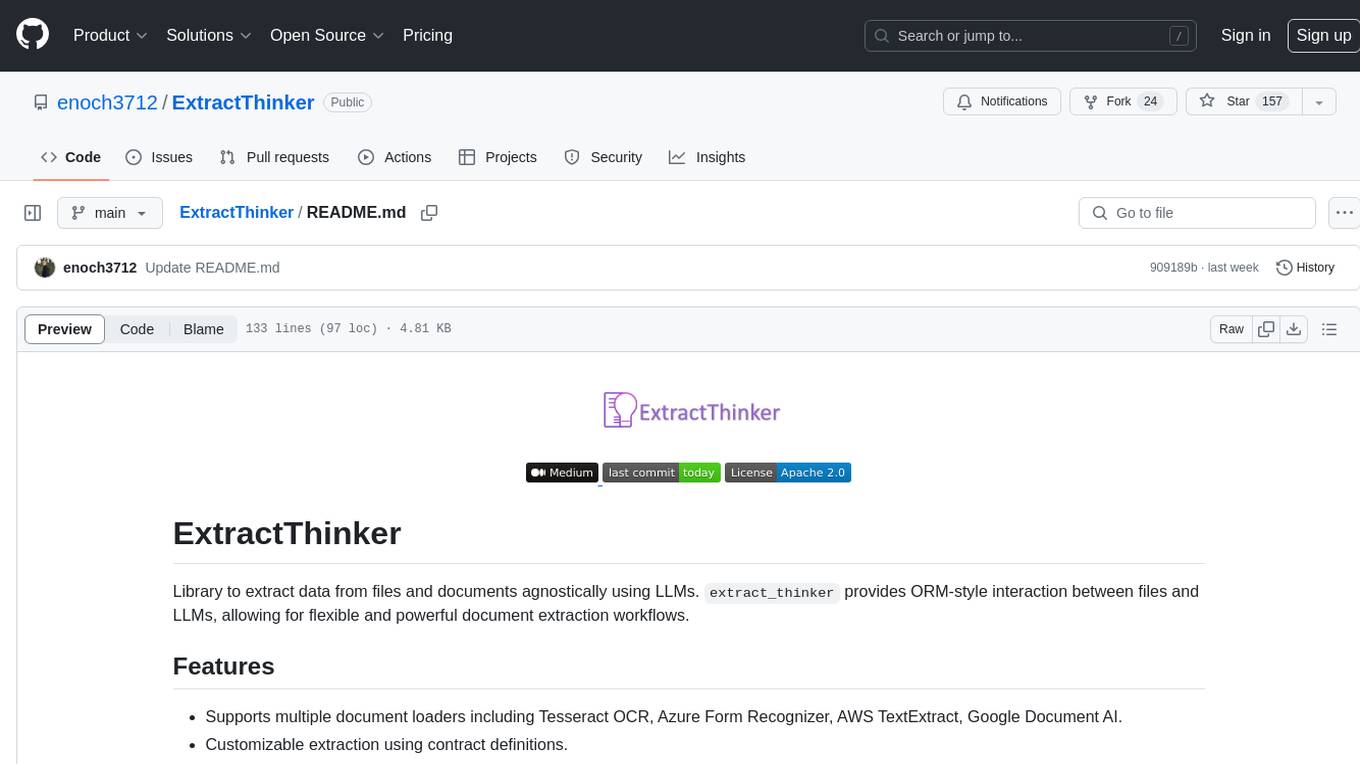
ExtractThinker
ExtractThinker is a library designed for extracting data from files and documents using Language Model Models (LLMs). It offers ORM-style interaction between files and LLMs, supporting multiple document loaders such as Tesseract OCR, Azure Form Recognizer, AWS TextExtract, and Google Document AI. Users can customize extraction using contract definitions, process documents asynchronously, handle various document formats efficiently, and split and process documents. The project is inspired by the LangChain ecosystem and focuses on Intelligent Document Processing (IDP) using LLMs to achieve high accuracy in document extraction tasks.
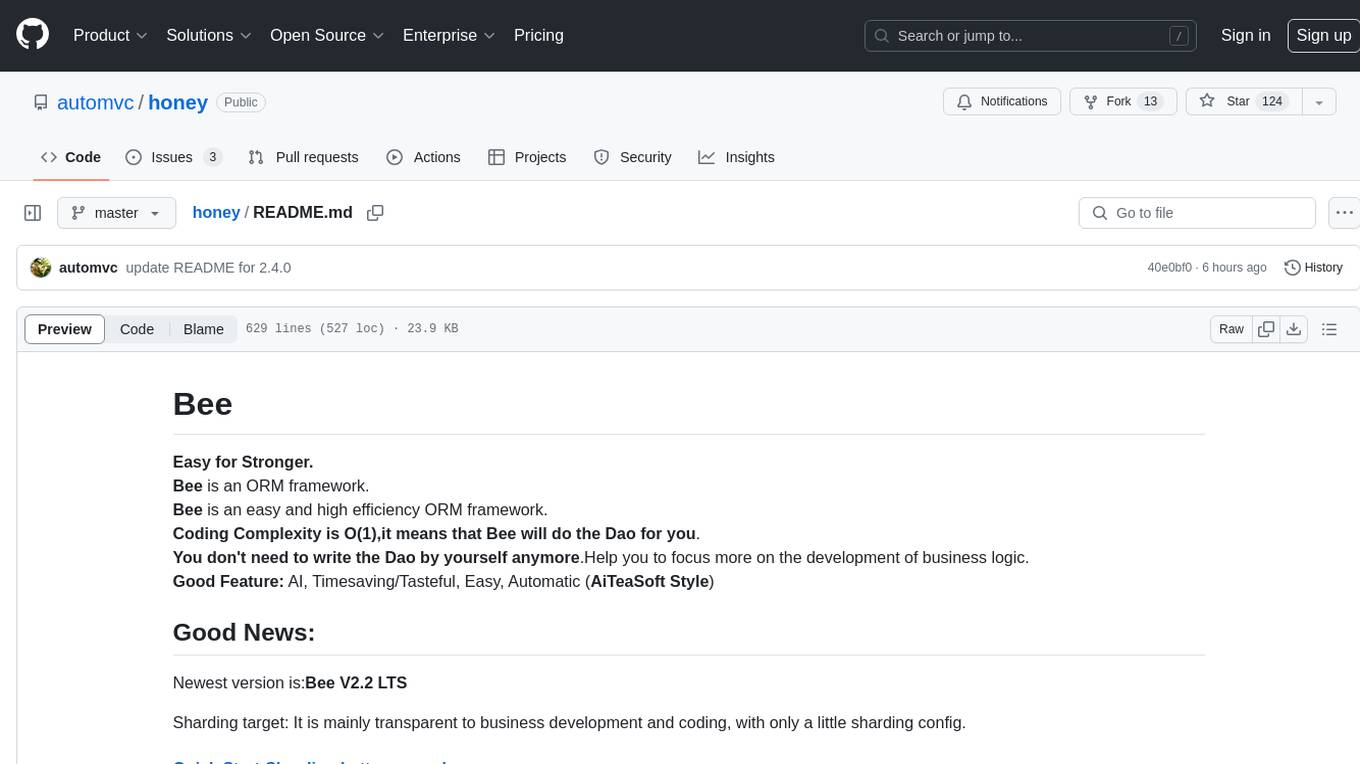
honey
Bee is an ORM framework that provides easy and high-efficiency database operations, allowing developers to focus on business logic development. It supports various databases and features like automatic filtering, partial field queries, pagination, and JSON format results. Bee also offers advanced functionalities like sharding, transactions, complex queries, and MongoDB ORM. The tool is designed for rapid application development in Java, offering faster development for Java Web and Spring Cloud microservices. The Enterprise Edition provides additional features like financial computing support, automatic value insertion, desensitization, dictionary value conversion, multi-tenancy, and more.
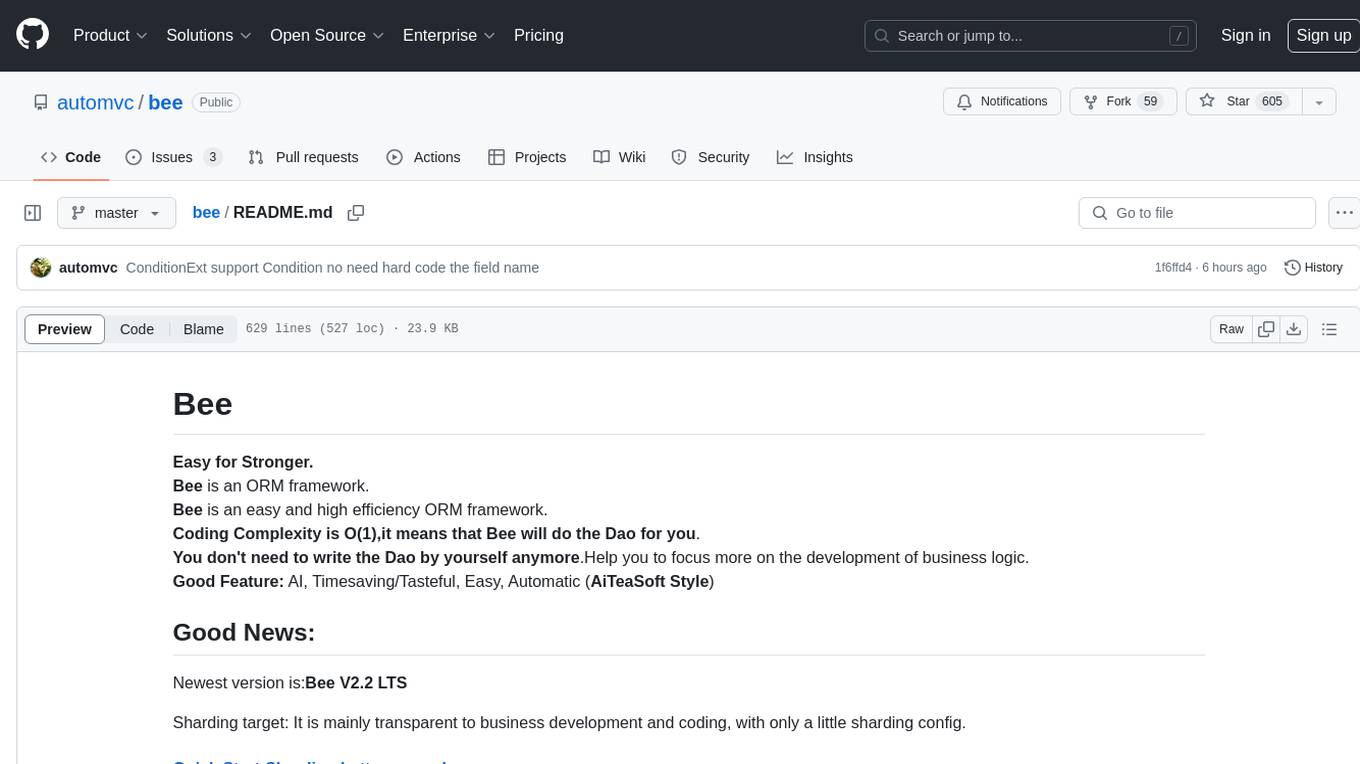
bee
Bee is an easy and high efficiency ORM framework that simplifies database operations by providing a simple interface and eliminating the need to write separate DAO code. It supports various features such as automatic filtering of properties, partial field queries, native statement pagination, JSON format results, sharding, multiple database support, and more. Bee also offers powerful functionalities like dynamic query conditions, transactions, complex queries, MongoDB ORM, cache management, and additional tools for generating distributed primary keys, reading Excel files, and more. The newest versions introduce enhancements like placeholder precompilation, default date sharding, ElasticSearch ORM support, and improved query capabilities.
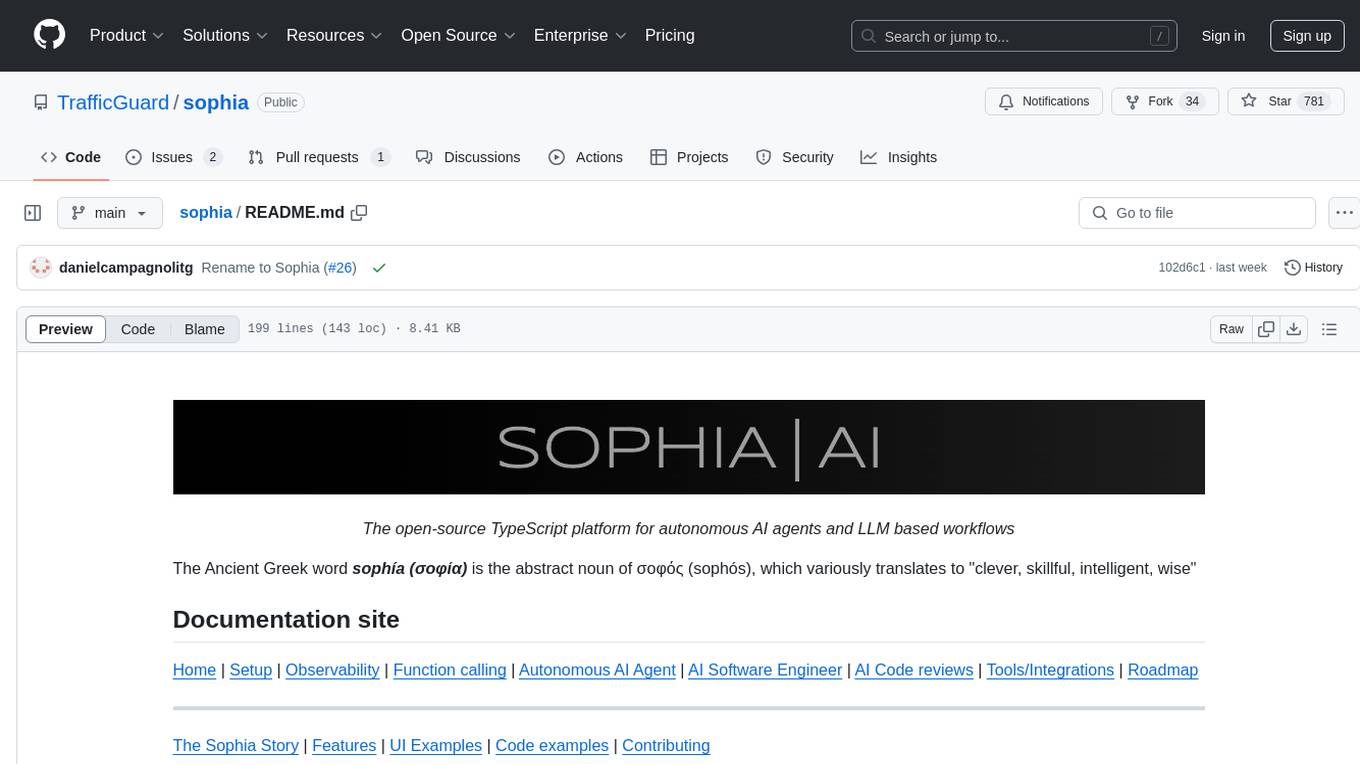
sophia
Sophia is an open-source TypeScript platform designed for autonomous AI agents and LLM based workflows. It aims to automate processes, review code, assist with refactorings, and support various integrations. The platform offers features like advanced autonomous agents, reasoning/planning inspired by Google's Self-Discover paper, memory and function call history, adaptive iterative planning, and more. Sophia supports multiple LLMs/services, CLI and web interface, human-in-the-loop interactions, flexible deployment options, observability with OpenTelemetry tracing, and specific agents for code editing, software engineering, and code review. It provides a flexible platform for the TypeScript community to expand and support various use cases and integrations.
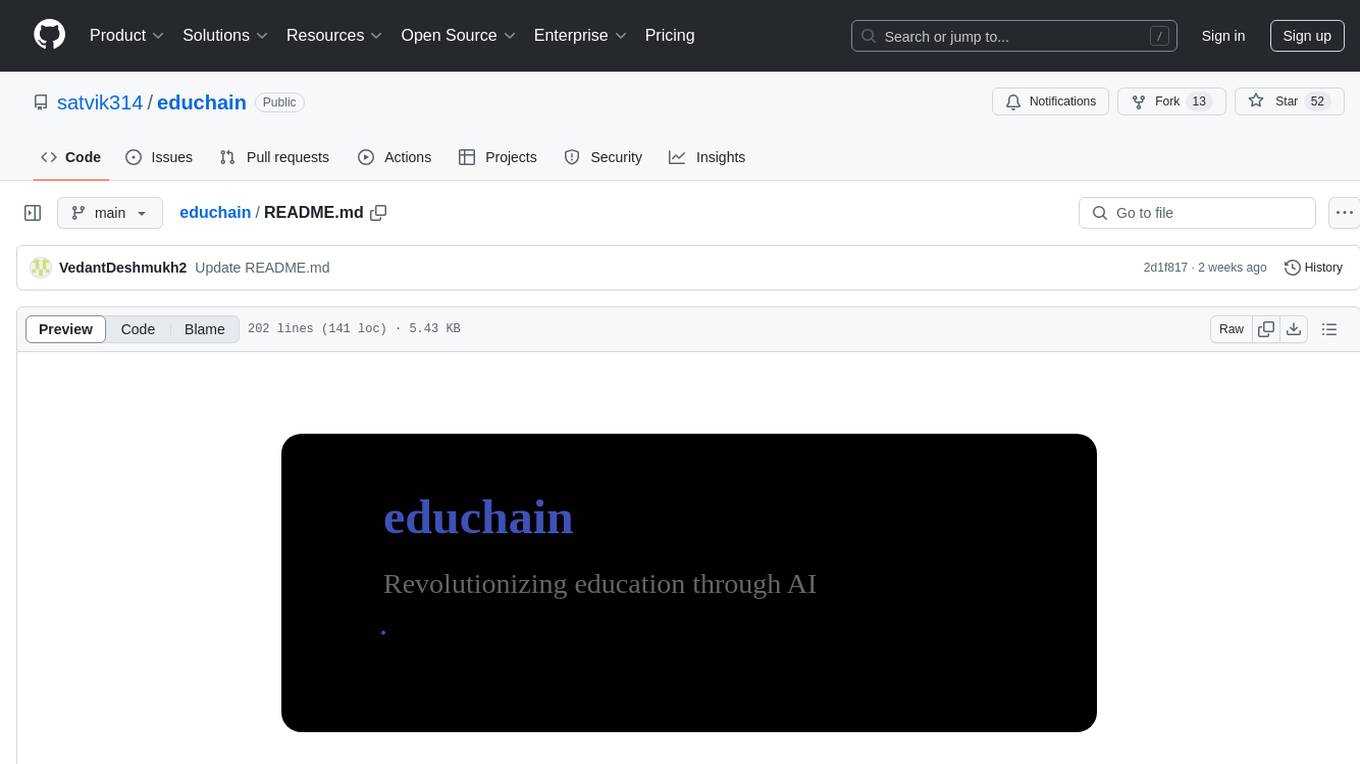
educhain
Educhain is a powerful Python package that leverages Generative AI to create engaging and personalized educational content. It enables users to generate multiple-choice questions, create lesson plans, and support various LLM models. Users can export questions to JSON, PDF, and CSV formats, customize prompt templates, and generate questions from text, PDF, URL files, youtube videos, and images. Educhain outperforms traditional methods in content generation speed and quality. It offers advanced configuration options and has a roadmap for future enhancements, including integration with popular Learning Management Systems and a mobile app for content generation on-the-go.
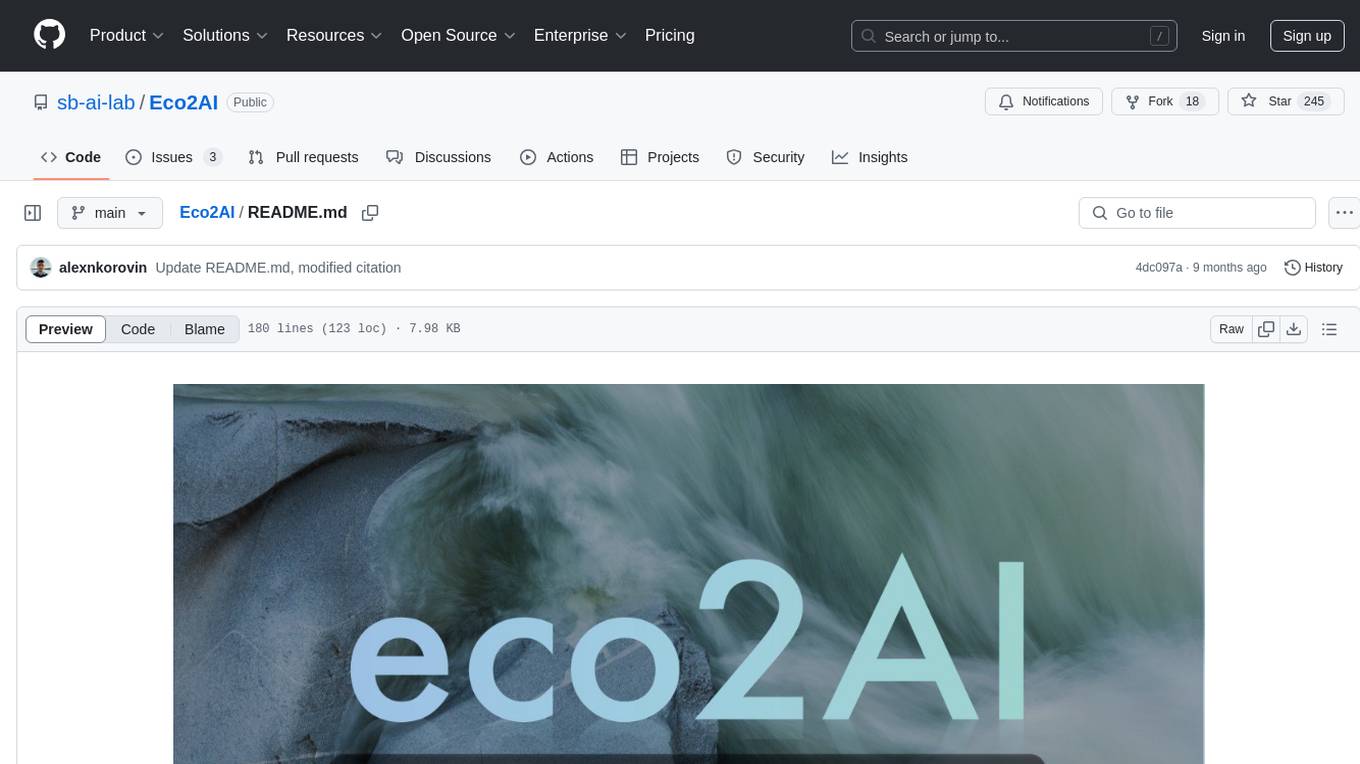
Eco2AI
Eco2AI is a python library for CO2 emission tracking that monitors energy consumption of CPU & GPU devices and estimates equivalent carbon emissions based on regional emission coefficients. Users can easily integrate Eco2AI into their Python scripts by adding a few lines of code. The library records emissions data and device information in a local file, providing detailed session logs with project names, experiment descriptions, start times, durations, power consumption, CO2 emissions, CPU and GPU names, operating systems, and countries.
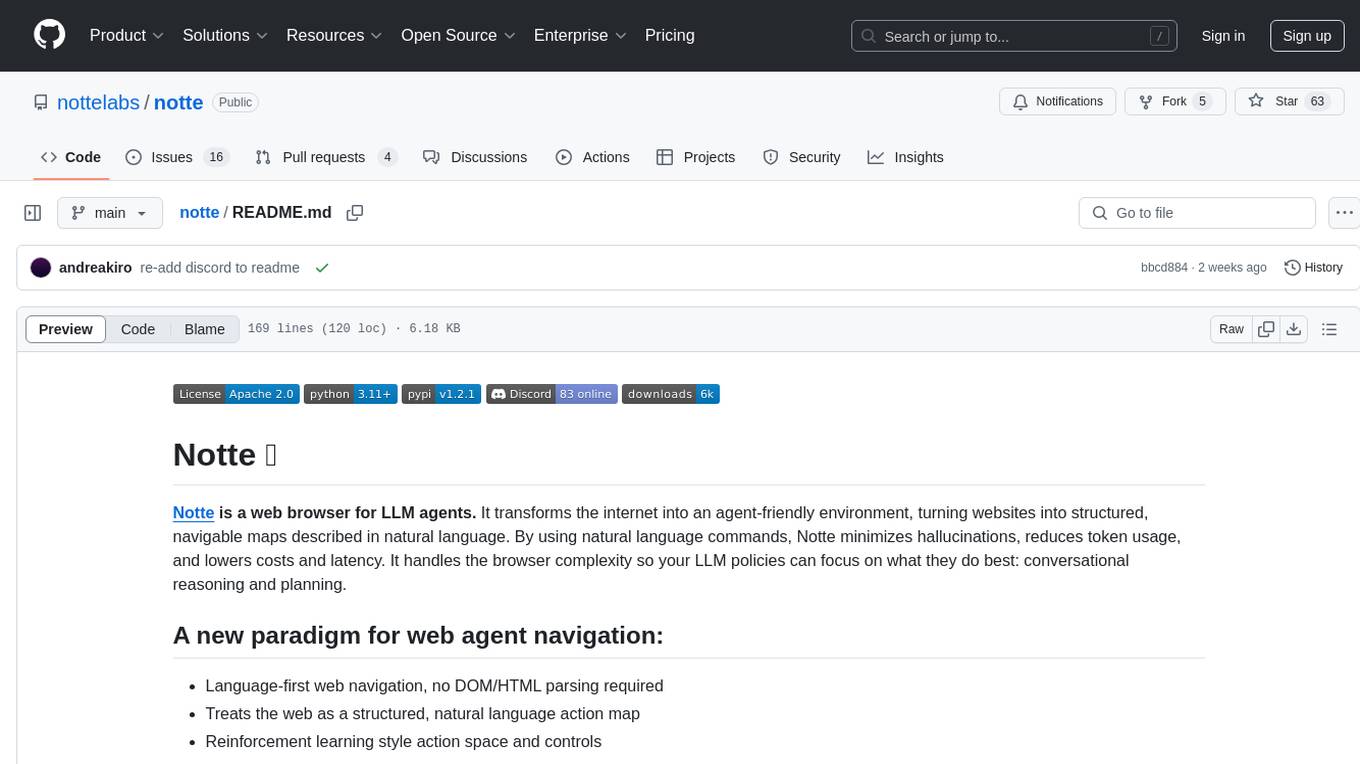
notte
Notte is a web browser designed specifically for LLM agents, providing a language-first web navigation experience without the need for DOM/HTML parsing. It transforms websites into structured, navigable maps described in natural language, enabling users to interact with the web using natural language commands. By simplifying browser complexity, Notte allows LLM policies to focus on conversational reasoning and planning, reducing token usage, costs, and latency. The tool supports various language model providers and offers a reinforcement learning style action space and controls for full navigation control.
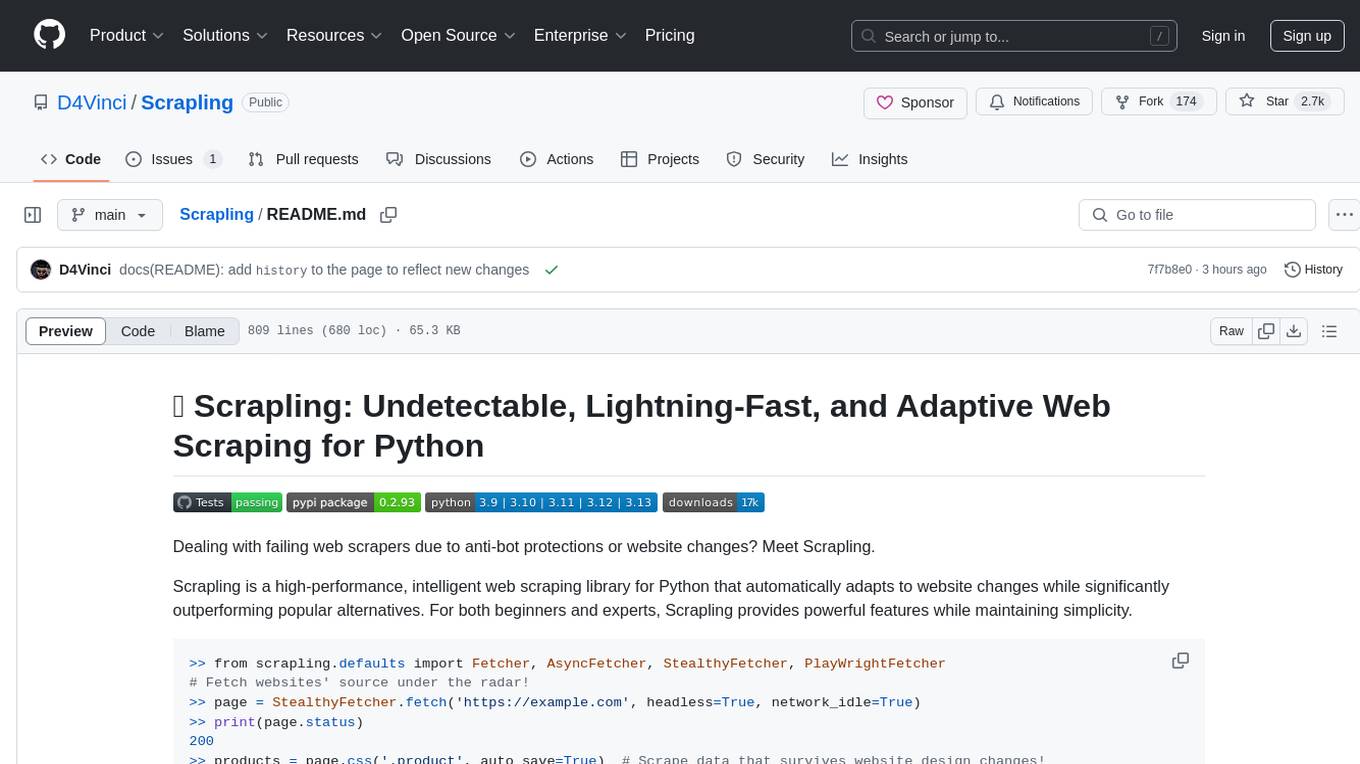
Scrapling
Scrapling is a high-performance, intelligent web scraping library for Python that automatically adapts to website changes while significantly outperforming popular alternatives. For both beginners and experts, Scrapling provides powerful features while maintaining simplicity. It offers features like fast and stealthy HTTP requests, adaptive scraping with smart element tracking and flexible selection, high performance with lightning-fast speed and memory efficiency, and developer-friendly navigation API and rich text processing. It also includes advanced parsing features like smart navigation, content-based selection, handling structural changes, and finding similar elements. Scrapling is designed to handle anti-bot protections and website changes effectively, making it a versatile tool for web scraping tasks.
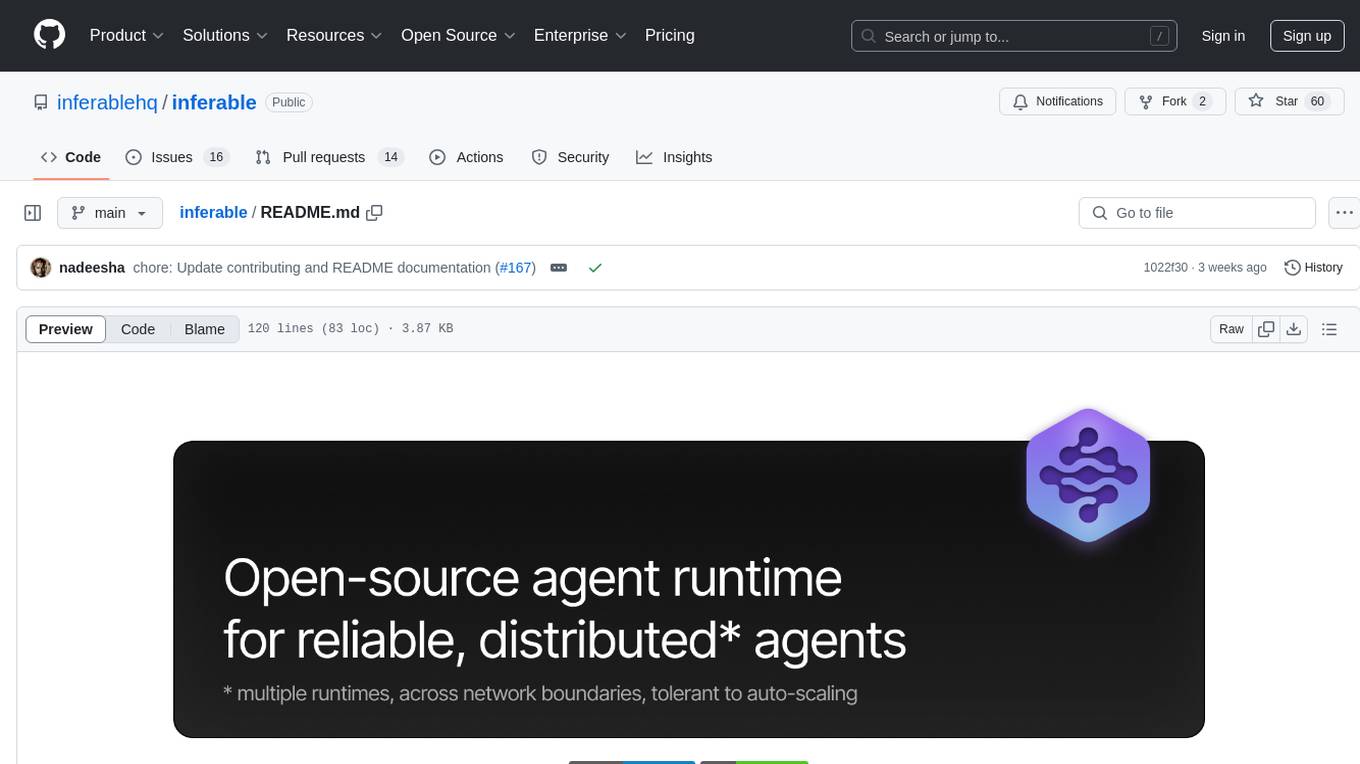
inferable
Inferable is an open source platform that helps users build reliable LLM-powered agentic automations at scale. It offers a managed agent runtime, durable tool calling, zero network configuration, multiple language support, and is fully open source under the MIT license. Users can define functions, register them with Inferable, and create runs that utilize these functions to automate tasks. The platform supports Node.js/TypeScript, Go, .NET, and React, and provides SDKs, core services, and bootstrap templates for various languages.
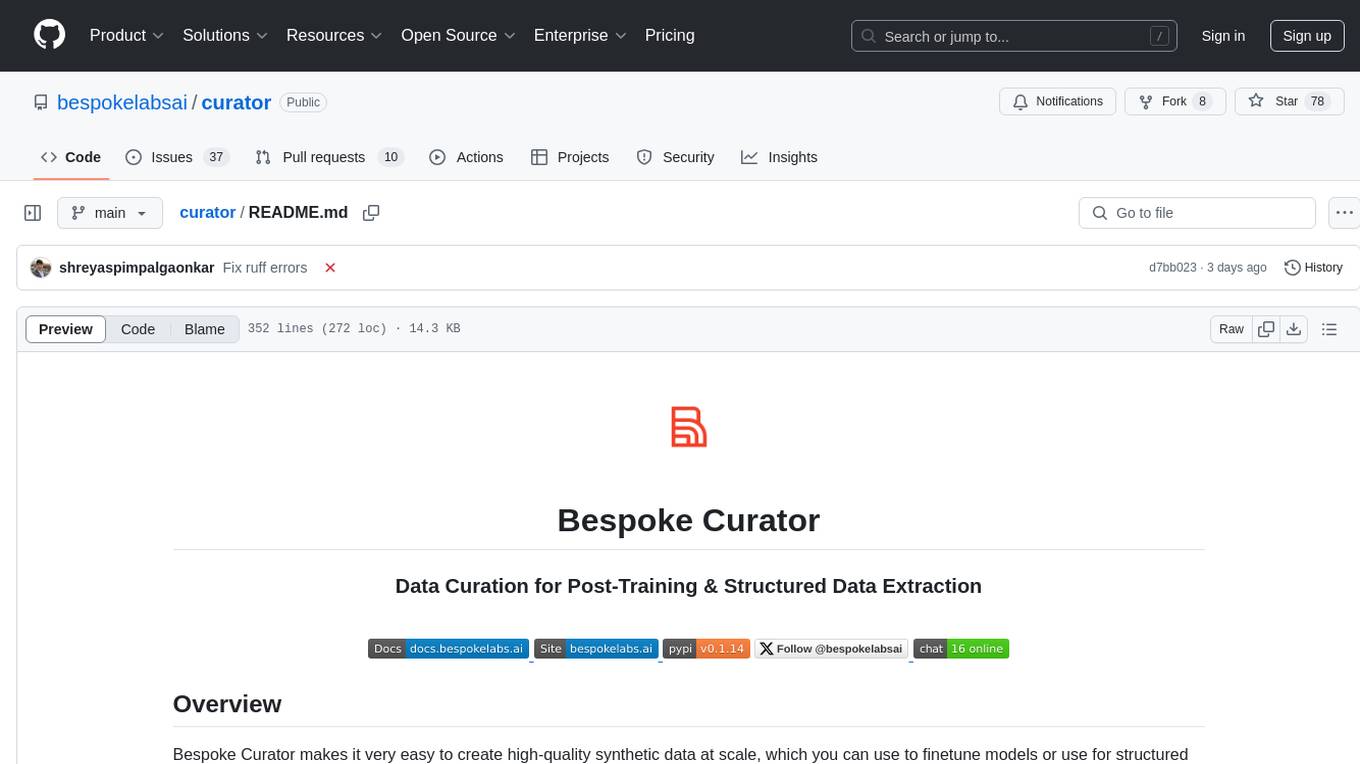
curator
Bespoke Curator is an open-source tool for data curation and structured data extraction. It provides a Python library for generating synthetic data at scale, with features like programmability, performance optimization, caching, and integration with HuggingFace Datasets. The tool includes a Curator Viewer for dataset visualization and offers a rich set of functionalities for creating and refining data generation strategies.
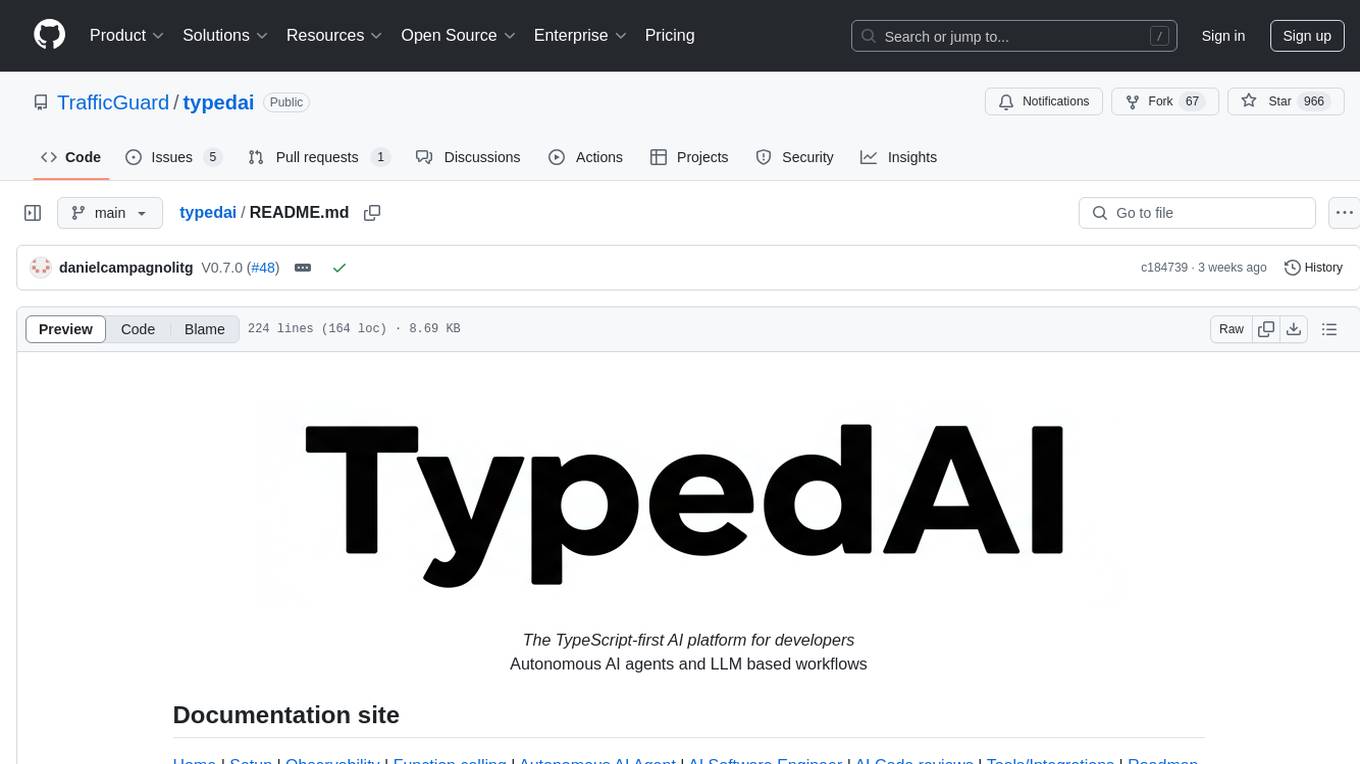
typedai
TypedAI is a TypeScript-first AI platform designed for developers to create and run autonomous AI agents, LLM based workflows, and chatbots. It offers advanced autonomous agents, software developer agents, pull request code review agent, AI chat interface, Slack chatbot, and supports various LLM services. The platform features configurable Human-in-the-loop settings, functional callable tools/integrations, CLI and Web UI interface, and can be run locally or deployed on the cloud with multi-user/SSO support. It leverages the Python AI ecosystem through executing Python scripts/packages and provides flexible run/deploy options like single user mode, Firestore & Cloud Run deployment, and multi-user SSO enterprise deployment. TypedAI also includes UI examples, code examples, and automated LLM function schemas for seamless development and execution of AI workflows.
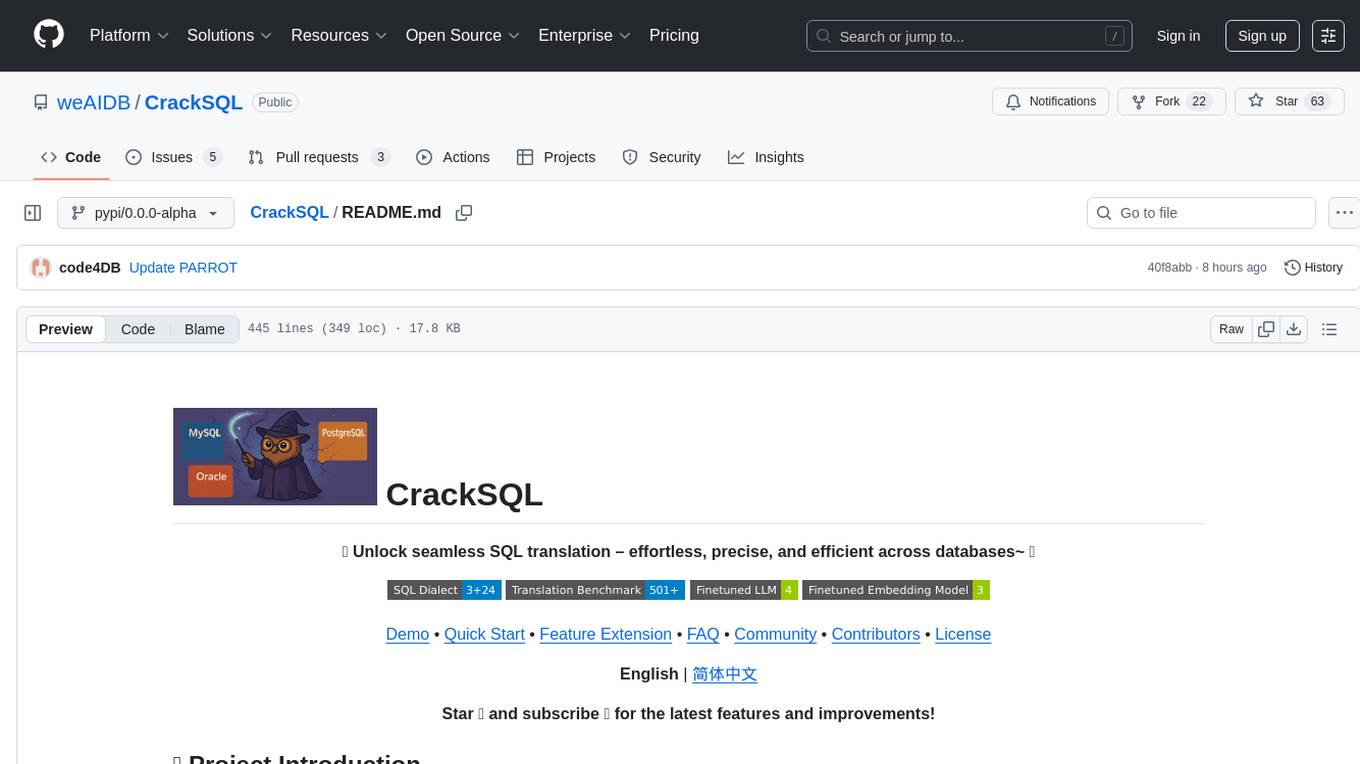
CrackSQL
CrackSQL is a powerful SQL dialect translation tool that integrates rule-based strategies with large language models (LLMs) for high accuracy. It enables seamless conversion between dialects (e.g., PostgreSQL → MySQL) with flexible access through Python API, command line, and web interface. The tool supports extensive dialect compatibility, precision & advanced processing, and versatile access & integration. It offers three modes for dialect translation and demonstrates high translation accuracy over collected benchmarks. Users can deploy CrackSQL using PyPI package installation or source code installation methods. The tool can be extended to support additional syntax, new dialects, and improve translation efficiency. The project is actively maintained and welcomes contributions from the community.
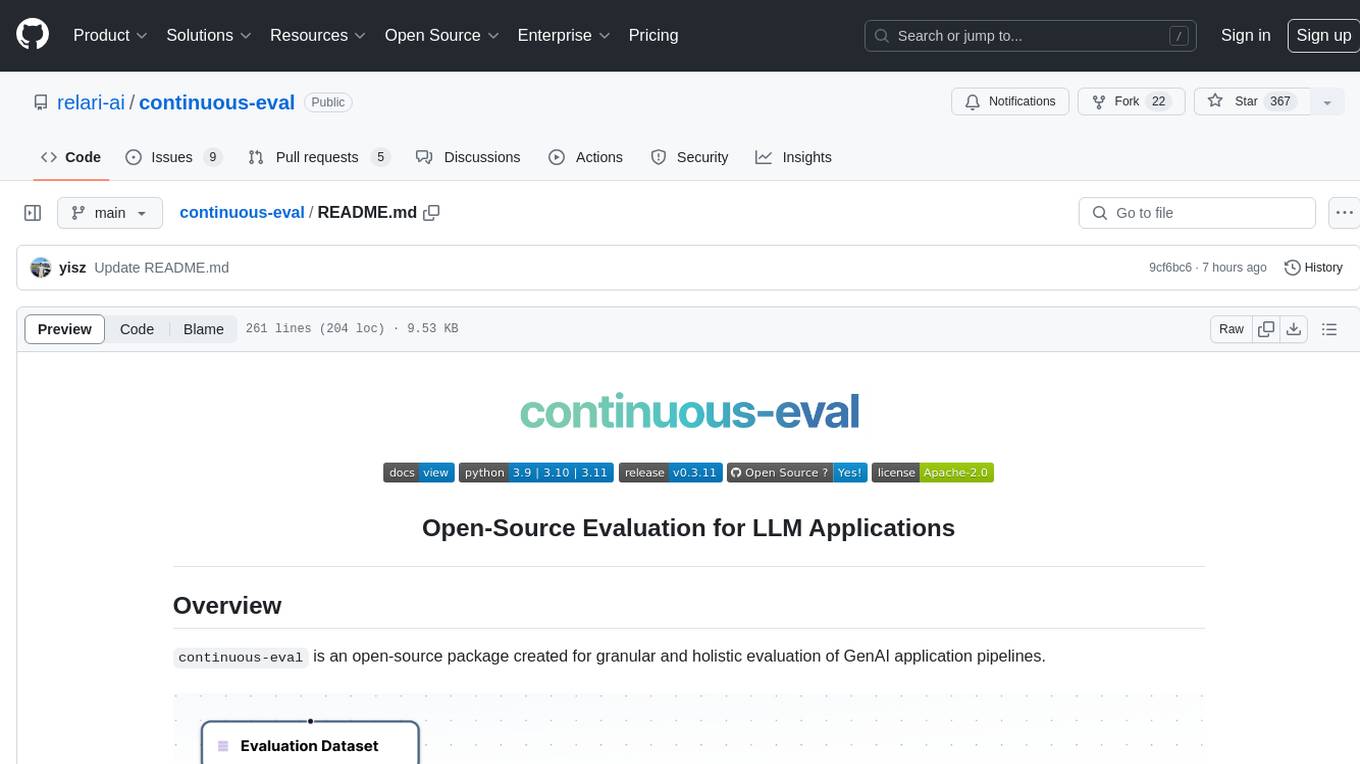
continuous-eval
Open-Source Evaluation for LLM Applications. `continuous-eval` is an open-source package created for granular and holistic evaluation of GenAI application pipelines. It offers modularized evaluation, a comprehensive metric library covering various LLM use cases, the ability to leverage user feedback in evaluation, and synthetic dataset generation for testing pipelines. Users can define their own metrics by extending the Metric class. The tool allows running evaluation on a pipeline defined with modules and corresponding metrics. Additionally, it provides synthetic data generation capabilities to create user interaction data for evaluation or training purposes.
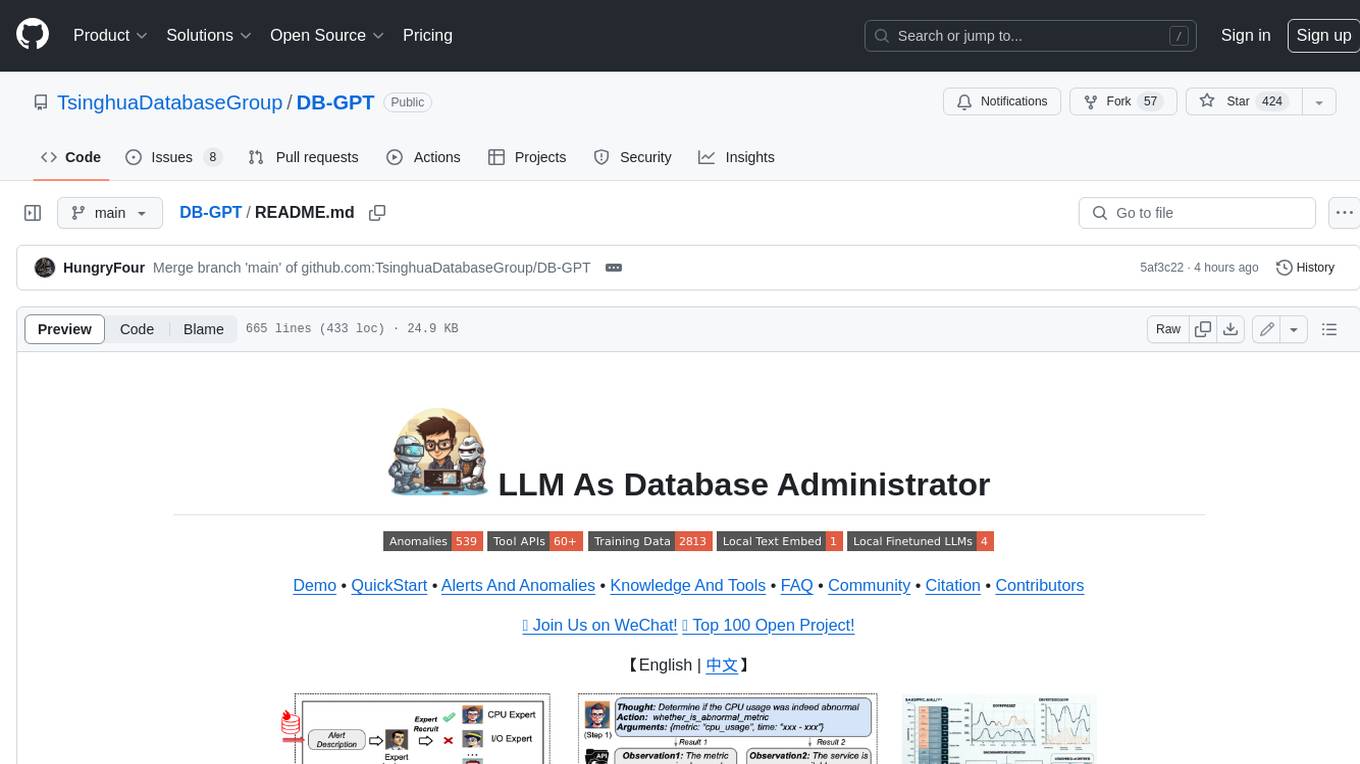
DB-GPT
DB-GPT is a personal database administrator that can solve database problems by reading documents, using various tools, and writing analysis reports. It is currently undergoing an upgrade. **Features:** * **Online Demo:** * Import documents into the knowledge base * Utilize the knowledge base for well-founded Q&A and diagnosis analysis of abnormal alarms * Send feedbacks to refine the intermediate diagnosis results * Edit the diagnosis result * Browse all historical diagnosis results, used metrics, and detailed diagnosis processes * **Language Support:** * English (default) * Chinese (add "language: zh" in config.yaml) * **New Frontend:** * Knowledgebase + Chat Q&A + Diagnosis + Report Replay * **Extreme Speed Version for localized llms:** * 4-bit quantized LLM (reducing inference time by 1/3) * vllm for fast inference (qwen) * Tiny LLM * **Multi-path extraction of document knowledge:** * Vector database (ChromaDB) * RESTful Search Engine (Elasticsearch) * **Expert prompt generation using document knowledge** * **Upgrade the LLM-based diagnosis mechanism:** * Task Dispatching -> Concurrent Diagnosis -> Cross Review -> Report Generation * Synchronous Concurrency Mechanism during LLM inference * **Support monitoring and optimization tools in multiple levels:** * Monitoring metrics (Prometheus) * Flame graph in code level * Diagnosis knowledge retrieval (dbmind) * Logical query transformations (Calcite) * Index optimization algorithms (for PostgreSQL) * Physical operator hints (for PostgreSQL) * Backup and Point-in-time Recovery (Pigsty) * **Continuously updated papers and experimental reports** This project is constantly evolving with new features. Don't forget to star ⭐ and watch 👀 to stay up to date.
For similar tasks

MarkLLM
MarkLLM is an open-source toolkit designed for watermarking technologies within large language models (LLMs). It simplifies access, understanding, and assessment of watermarking technologies, supporting various algorithms, visualization tools, and evaluation modules. The toolkit aids researchers and the community in ensuring the authenticity and origin of machine-generated text.
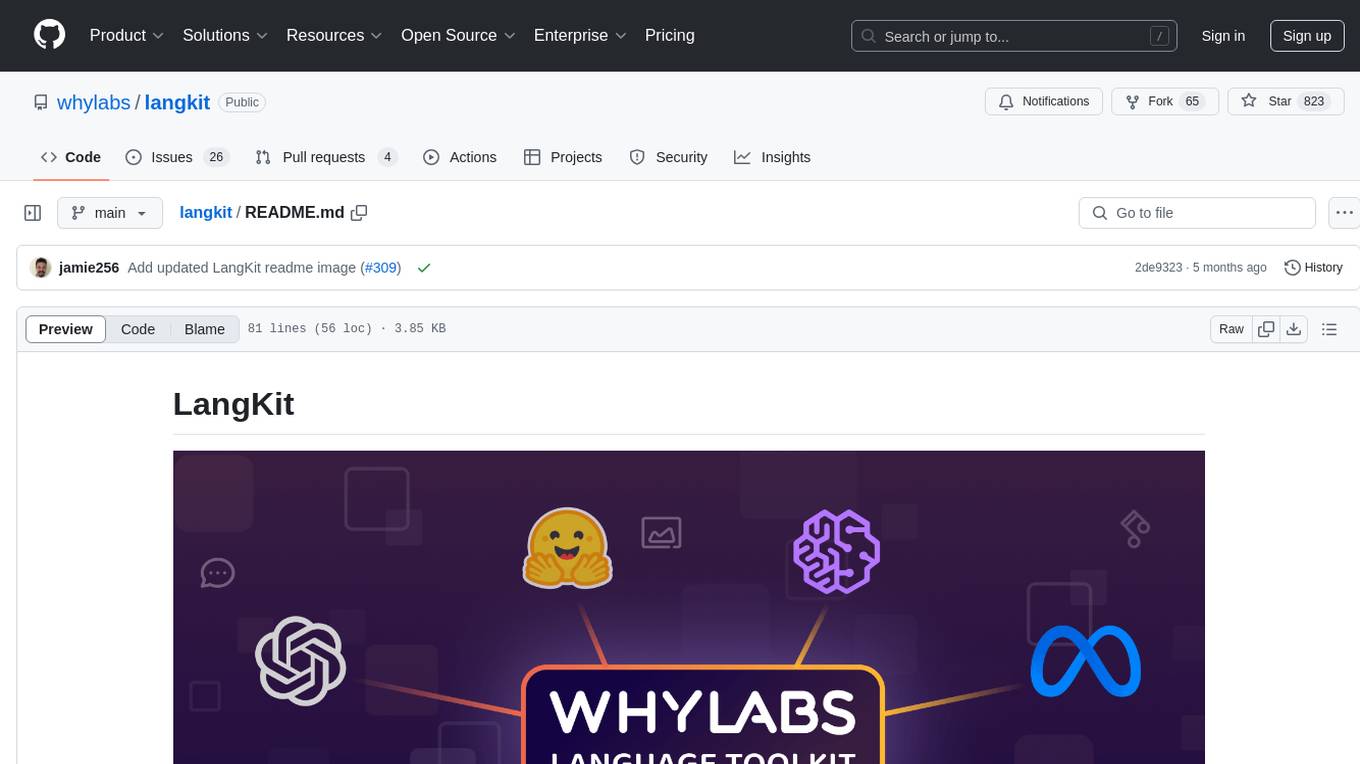
langkit
LangKit is an open-source text metrics toolkit for monitoring language models. It offers methods for extracting signals from input/output text, compatible with whylogs. Features include text quality, relevance, security, sentiment, toxicity analysis. Installation via PyPI. Modules contain UDFs for whylogs. Benchmarks show throughput on AWS instances. FAQs available.
For similar jobs

weave
Weave is a toolkit for developing Generative AI applications, built by Weights & Biases. With Weave, you can log and debug language model inputs, outputs, and traces; build rigorous, apples-to-apples evaluations for language model use cases; and organize all the information generated across the LLM workflow, from experimentation to evaluations to production. Weave aims to bring rigor, best-practices, and composability to the inherently experimental process of developing Generative AI software, without introducing cognitive overhead.

LLMStack
LLMStack is a no-code platform for building generative AI agents, workflows, and chatbots. It allows users to connect their own data, internal tools, and GPT-powered models without any coding experience. LLMStack can be deployed to the cloud or on-premise and can be accessed via HTTP API or triggered from Slack or Discord.

VisionCraft
The VisionCraft API is a free API for using over 100 different AI models. From images to sound.

kaito
Kaito is an operator that automates the AI/ML inference model deployment in a Kubernetes cluster. It manages large model files using container images, avoids tuning deployment parameters to fit GPU hardware by providing preset configurations, auto-provisions GPU nodes based on model requirements, and hosts large model images in the public Microsoft Container Registry (MCR) if the license allows. Using Kaito, the workflow of onboarding large AI inference models in Kubernetes is largely simplified.

PyRIT
PyRIT is an open access automation framework designed to empower security professionals and ML engineers to red team foundation models and their applications. It automates AI Red Teaming tasks to allow operators to focus on more complicated and time-consuming tasks and can also identify security harms such as misuse (e.g., malware generation, jailbreaking), and privacy harms (e.g., identity theft). The goal is to allow researchers to have a baseline of how well their model and entire inference pipeline is doing against different harm categories and to be able to compare that baseline to future iterations of their model. This allows them to have empirical data on how well their model is doing today, and detect any degradation of performance based on future improvements.

tabby
Tabby is a self-hosted AI coding assistant, offering an open-source and on-premises alternative to GitHub Copilot. It boasts several key features: * Self-contained, with no need for a DBMS or cloud service. * OpenAPI interface, easy to integrate with existing infrastructure (e.g Cloud IDE). * Supports consumer-grade GPUs.

spear
SPEAR (Simulator for Photorealistic Embodied AI Research) is a powerful tool for training embodied agents. It features 300 unique virtual indoor environments with 2,566 unique rooms and 17,234 unique objects that can be manipulated individually. Each environment is designed by a professional artist and features detailed geometry, photorealistic materials, and a unique floor plan and object layout. SPEAR is implemented as Unreal Engine assets and provides an OpenAI Gym interface for interacting with the environments via Python.

Magick
Magick is a groundbreaking visual AIDE (Artificial Intelligence Development Environment) for no-code data pipelines and multimodal agents. Magick can connect to other services and comes with nodes and templates well-suited for intelligent agents, chatbots, complex reasoning systems and realistic characters.



